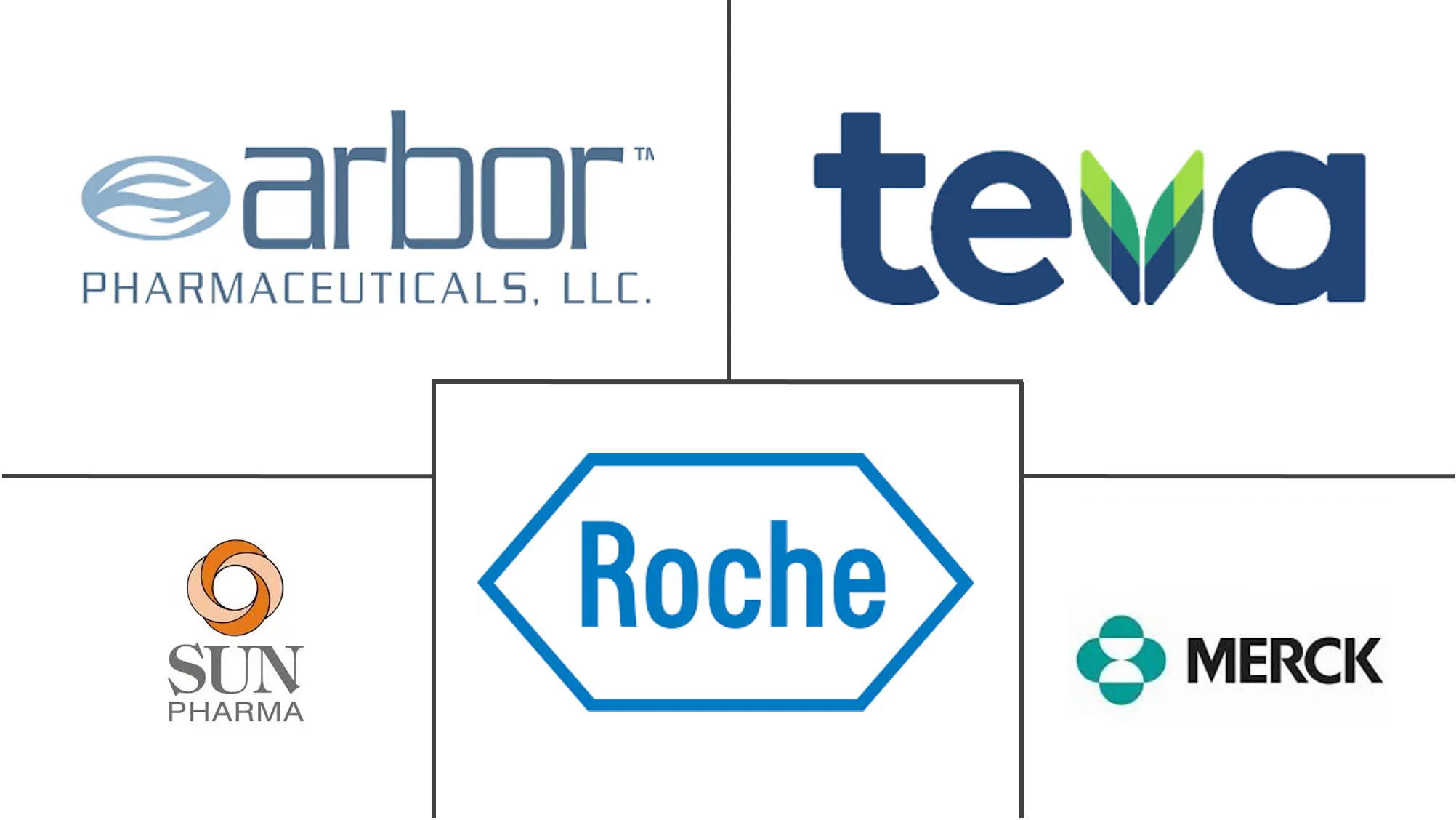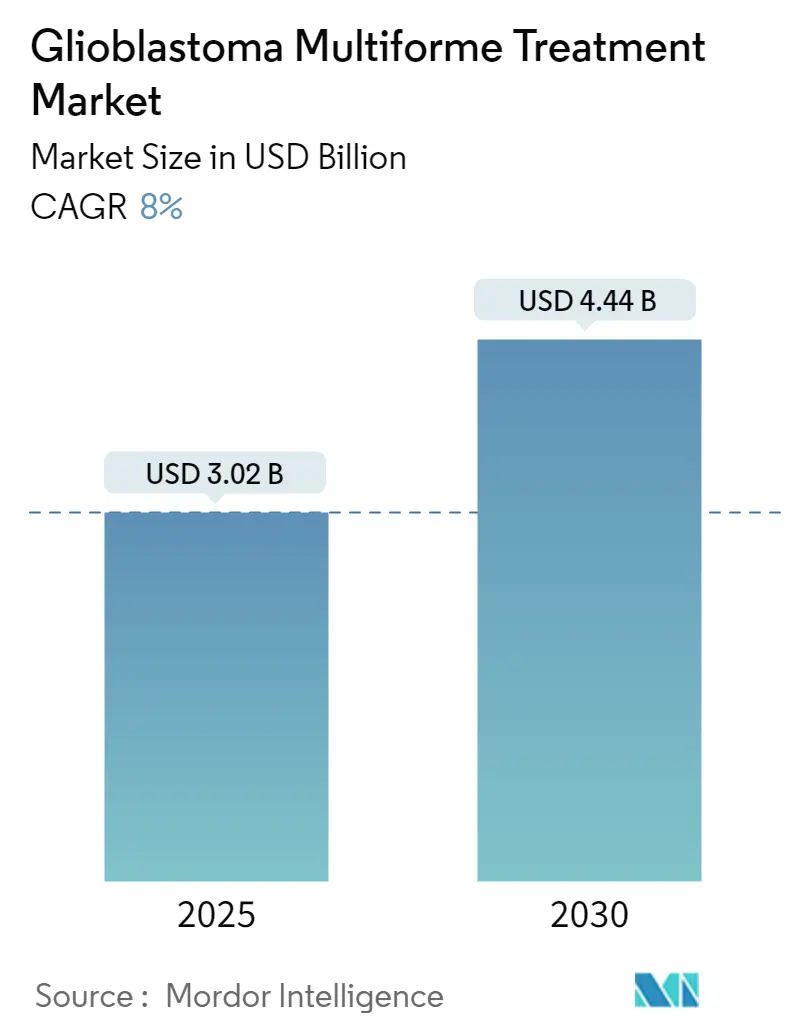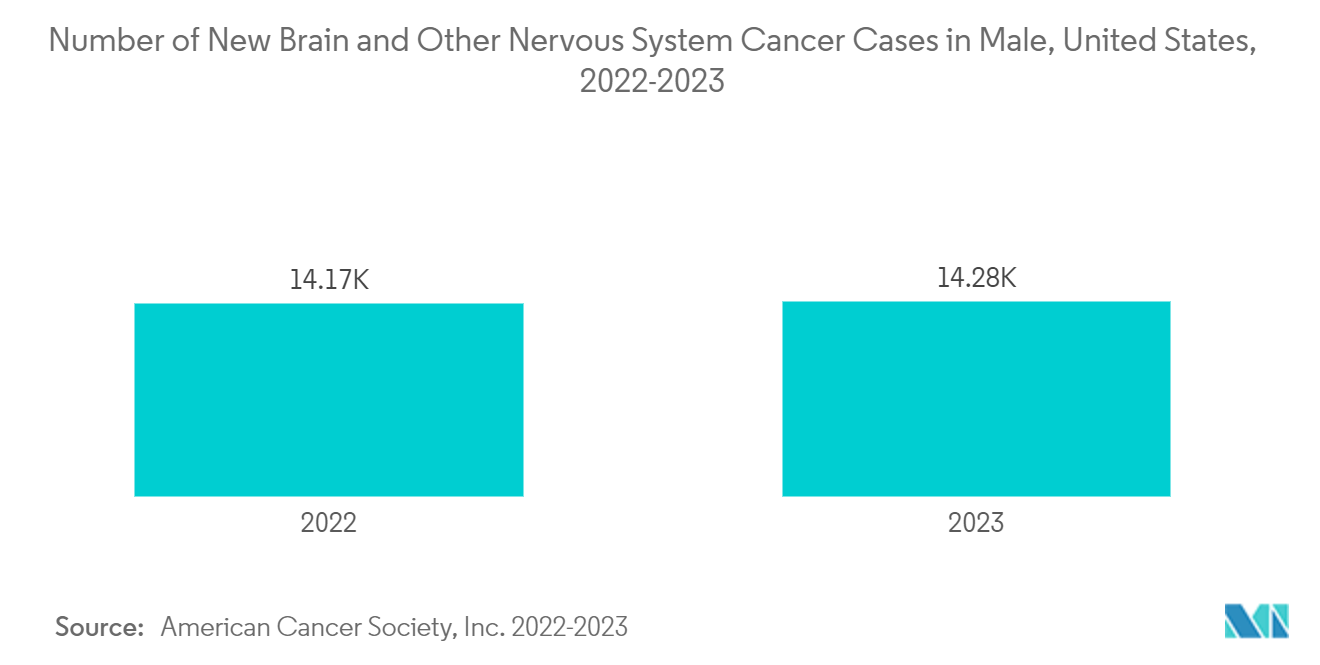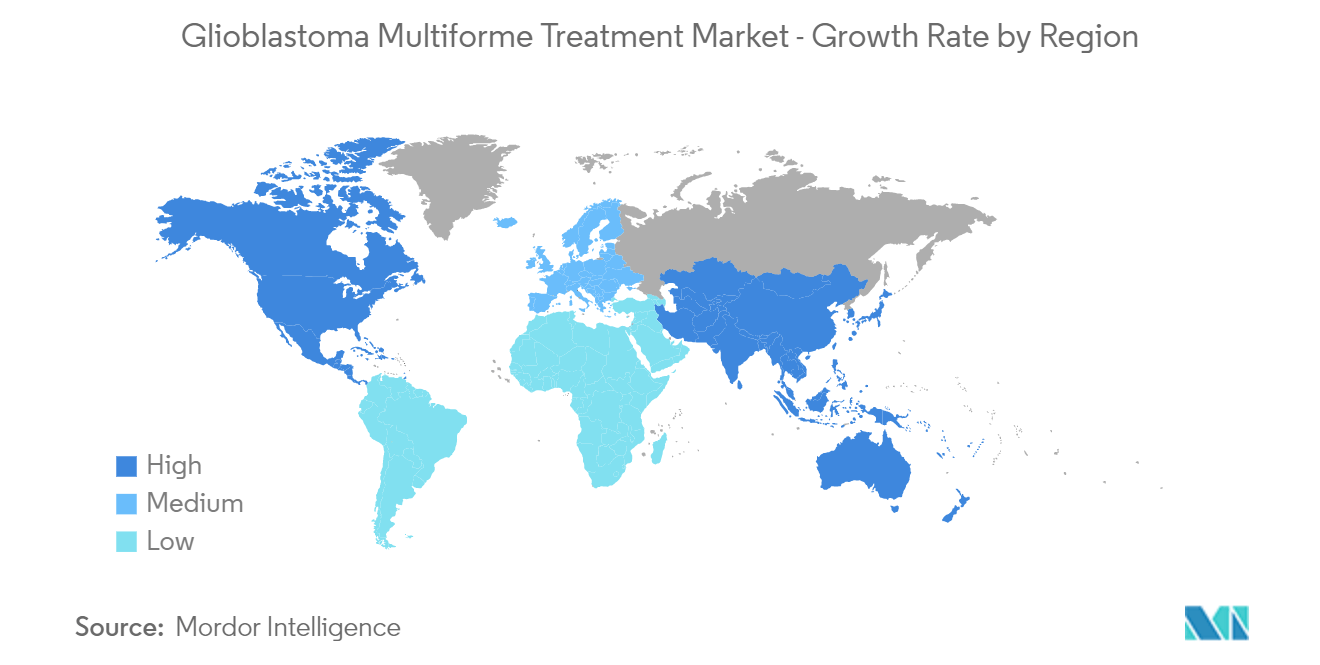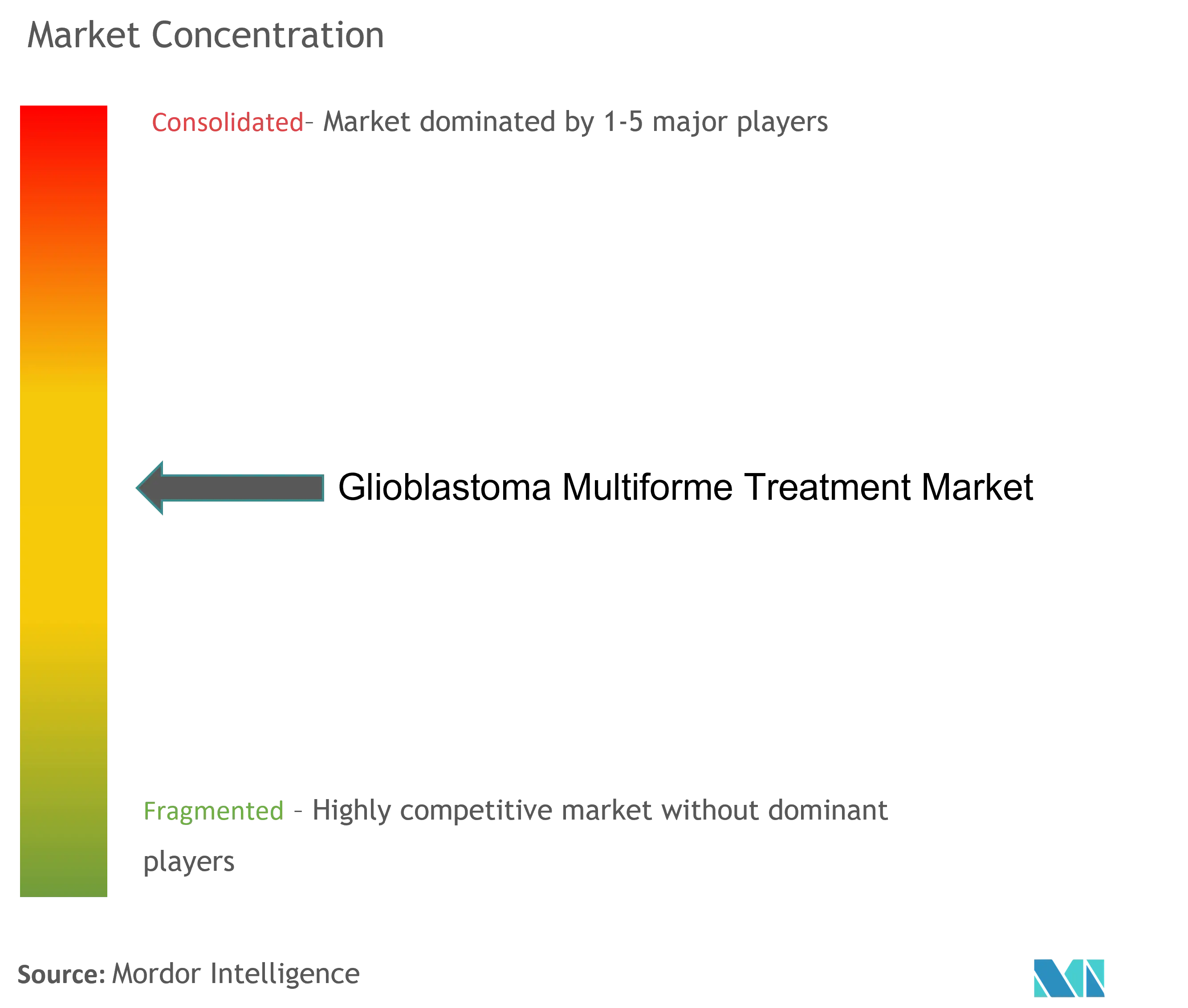Glioblastoma Multiforme Treatment Market Analysis
The Glioblastoma Multiforme Treatment Market size is estimated at USD 3.02 billion in 2025, and is expected to reach USD 4.44 billion by 2030, at a CAGR of 8% during the forecast period (2025-2030).
According to an article published by Acta bio-medica: Atenei Parmensis in July 2022, the international scientific community urgently reorganized the treatment approach to minimize the risk of in-hospital contagious. For glioblastoma multiforme patients, adjuvant treatments were evaluated, and a hypofractionated radiotherapy regimen was preferred to reduce daily hospital access. Furthermore, the above source mentioned that the patient-doctor relationship improved through telemedicine. Thus, telemedicine benefits the health system financially, provides psychological satisfaction to the patient, and provides equate medical care for glioblastoma multiforme patients. This led to increased glioblastoma multiforme treatment, thereby driving the market growth.
Factors such as the increasing burden of brain disorders, vital R&D initiatives from key players, and a rising senior population are boosting the growth of the glioblastoma multiforme treatment market. For instance, according to an article published by the National Brain Tumor Society, more than 13,000 Americans are expected to receive a glioblastoma multiforme diagnosis in 2022. Glioblastoma multiforme accounts for 49.1% of all primary malignant brain tumors. It is estimated that more than 10,000 individuals in the United States will succumb to glioblastoma every year. Thus, with increased glioblastoma multiforme cases, the demand for its treatment increases, leading to market growth.
Moreover, various initiatives undertaken by the regional and state governments to make the treatment more accessible to patients are anticipated to boost the market growth further. For instance, in December 2022, the Food and Drug Administration (FDA) granted Fast Track designation to WP1122 for treating glioblastoma multiforme. WP1122 was a prodrug of 2-deoxy-D-glucose, or 2-DG, designed to target glycolysis and glycosylation, limiting viral infectivity and replication. Such an initiative is expected to increase the demand for glioblastoma multiforme treatment, driving market growth.
Hence, as per the abovementioned factors, the glioblastoma multiforme treatment market is anticipated to grow over the forecast period. However, reimbursement issues, stringent regulatory guidelines, and high cost & side effects associated with therapies are expected to restrain the growth of the global market over the analysis period.
Glioblastoma Multiforme Treatment Market Trends
Chemotherapy Segment is Expected to Dominate the Market Over the Forecast Period
The key factors contributing to the growth of the radiation therapy segment are the rising number of brain and other nervous system cancers and the growing preference and commercial availability of chemotherapeutic agents for treating glioblastoma. For instance, according to an article published by the Chinese Clinical Oncology in December 2022, radiotherapy is essential for treating glioma, particularly high-grade glioma and glioblastoma multiforme. Radiotherapy techniques have improved with time, and many options have become available to minimize adverse effects and improve survival rates and quality of life. Proton therapy (PT), or proton beam radiation therapy (PBRT), offers certain advantages to other modern photon-based conformal therapy when used in the treatment of CNS malignancies such as glioblastoma multiforme. Thus, the adoption of radiotherapy due to its advantage is expected to drive segmental growth.
Furthermore, increasing developments and launches by manufacturers to meet the growing demand for innovative products are expected to drive market growth. For instance, in January 2022, ITM Isotope Technologies Munich SE reported a cooperation agreement for the clinical development of a radiopharmaceutical therapy candidate to treat malignant brain tumor glioblastoma. ITM and Helmholtz Munich collaborated to support an upcoming dose-escalation Phase I clinical trial with LuCaFab (ITM-31). LuCaFab is a CA XII-specific antibody Fab fragment targeting molecule, developed by Helmholtz Munich, radiolabeled with ITM's medical radioisotope no-carrier-added lutetium-177 (n.c.a. 177Lu, EndolucinBeta).
Thus, all the factors above are anticipated to boost the segment over the forecast period. In Chinese Clinical Oncology in December 2022, radiotherapy is essential to treating glioma, particularly high-grade glioma and glioblastoma multiforme. Radiotherapy techniques have improved with time, and many options have become available in the interest of minimizing adverse effects and improving survival rates and quality of life. Proton therapy (PT), or proton beam radiation therapy (PBRT), offers certain advantages to other modern photon-based conformal therapy when used in the treatment of CNS malignancies such as glioblastoma multiforme. Thus, the adoption of radiotherapy due to its advantage is expected to drive segmental growth.
Furthermore, increasing developments and launches by manufacturers to meet the growing demand for innovative products are expected to drive market growth. For instance, in January 2022, ITM Isotope Technologies Munich SE reported a cooperation agreement for the clinical development of a radiopharmaceutical therapy candidate to treat malignant brain tumor glioblastoma. ITM and Helmholtz Munich collaborated to support an upcoming dose-escalation Phase I clinical trial with LuCaFab (ITM-31). LuCaFab is a CA XII-specific antibody Fab fragment targeting molecule, developed by Helmholtz Munich, radiolabeled with ITM's medical radioisotope no-carrier-added lutetium-177 (n.c.a. 177Lu, EndolucinBeta).
Thus, all the aforementioned factors are anticipated to boost the segment over the forecast period.
North America leads the Glioblastoma Multiforme Treatment Market Over the Forecast Period
North America leads the glioblastoma multiforme treatment market, owing to increased funding initiatives and awareness among the patient population. The key factors driving the regional market's growth are government support for the development of the healthcare sector, widespread awareness of brain disorders and tumors, easy access to high-quality medical facilities, and favorable reimbursement policies.
According to the American Society of Clinical Oncology (ASCO), in February 2022, it was expected that an estimated 25,050 adults (14,170 men and 10,880 women) in the United States would be diagnosed with primary cancerous tumors of the brain and spinal cord in 2022. Additionally, as per the above source, brain tumors account for 85% to 90% of all primary CNS tumors. Moreover, about 4,170 children under the age of 15 were diagnosed with a brain or CNS tumor this year in the United States.
Furthermore, strategic activities by the key market players in the region are anticipated to boost the market's growth. For instance, in July 2022, Diffusion Pharmaceuticals Inc. reported that after collaboration with the United States Food and Drug Administration on the design of their Phase 2 clinical trial entitled 'Open-Label, Dose-Escalation, Phase 2 Safety and Efficacy Study of TSC in Newly Diagnosed Glioblastoma ('GBM') Patients when Administered with Standard of Care.
Thus, given the aforementioned factors, North America's glioblastoma multiforme treatment market is expected to grow significantly over the forecast period.
Glioblastoma Multiforme Treatment Industry Overview
The glioblastoma multiforme treatment market is moderately concentrated in nature due to the presence of companies operating globally as well as regionally. The competitive landscape includes an analysis of a few international as well as local companies that hold market shares and are well known, including Arbor Pharmaceuticals, Bristol-Myers Squibb, Eli Lilly and Company, F. Hoffmann-La Roche Ltd, Merck & Co. Inc., Sun Pharmaceuticals, and Teva Pharmaceutical Industries Ltd.
Glioblastoma Multiforme Treatment Market Leaders
-
Arbor Pharmaceuticals, LLC
-
F. Hoffmann-La Roche Ltd
-
Merck & Co. Inc.
-
Sun Pharmaceutical Industries Ltd.
-
Teva Pharmaceutical Industries Ltd.
- *Disclaimer: Major Players sorted in no particular order
Glioblastoma Multiforme Treatment Market News
- June 2023: Chimeric Therapeutics activated the Phase 1B clinical trial in patients with recurrent and/ or progressive glioblastoma multiforme (GBM) to assess the safety and efficacy of CHM 1101, the company's first-in-class CLTX CAR T cell therapy.
- August 2022: Northwest Biotherapeutics received approval from the United Kingdom Medicines and Healthcare Products Regulatory Agency (MHRA) for the Company's Pediatric Investigation Plan (PIP). The development, regulatory review, and regulatory approval of a PIP is a prerequisite for the application for approval of new medicine for adult patients, such as DCVax-L.
Glioblastoma Multiforme Treatment Industry Segmentation
Glioblastoma multiforme (GBM), also known as glioblastoma, is the most common type of malignant brain tumor. A brain tumor arises from the abnormal growth of cancerous cells in the brain. The glioblastoma multiforme treatment market was segmented by treatment (chemotherapy, radiation therapy, and other treatments), end-user (hospitals/clinics and ambulatory surgical centers), and geography (North America, Europe, Asia-Pacific, Middle East and Africa, and South America). The market report also covers the estimated market sizes and trends for 17 different countries across major regions globally. The report offers the value (USD) for the above segments.
| By Treatment | Chemotherapy | Temozolomide | |
| Bevacizumab | |||
| Carmustine | |||
| Other Types of Chemotherapy | |||
| Radiation Therapy | |||
| Other Treatments | |||
| By End -User | Hospitals/Clinics | ||
| Ambulatory Surgical Centers | |||
| Geography | North America | United States | |
| Canada | |||
| Mexico | |||
| Europe | Germany | ||
| United Kingdom | |||
| France | |||
| Italy | |||
| Spain | |||
| Rest of Europe | |||
| Asia-Pacific | China | ||
| Japan | |||
| India | |||
| Australia | |||
| South Korea | |||
| Rest of Asia-Pacific | |||
| Middle East and Africa | GCC | ||
| South Africa | |||
| Rest of Middle East and Africa | |||
| South America | Brazil | ||
| Argentina | |||
| Rest of South America | |||
Glioblastoma Multiforme Treatment Market Research Faqs
How big is the Glioblastoma Multiforme Treatment Market?
The Glioblastoma Multiforme Treatment Market size is expected to reach USD 3.02 billion in 2025 and grow at a CAGR of 8% to reach USD 4.44 billion by 2030.
What is the current Glioblastoma Multiforme Treatment Market size?
In 2025, the Glioblastoma Multiforme Treatment Market size is expected to reach USD 3.02 billion.
Who are the key players in Glioblastoma Multiforme Treatment Market?
Arbor Pharmaceuticals, LLC, F. Hoffmann-La Roche Ltd, Merck & Co. Inc., Sun Pharmaceutical Industries Ltd. and Teva Pharmaceutical Industries Ltd. are the major companies operating in the Glioblastoma Multiforme Treatment Market.
Which is the fastest growing region in Glioblastoma Multiforme Treatment Market?
Asia Pacific is estimated to grow at the highest CAGR over the forecast period (2025-2030).
Which region has the biggest share in Glioblastoma Multiforme Treatment Market?
In 2025, the North America accounts for the largest market share in Glioblastoma Multiforme Treatment Market.
What years does this Glioblastoma Multiforme Treatment Market cover, and what was the market size in 2024?
In 2024, the Glioblastoma Multiforme Treatment Market size was estimated at USD 2.78 billion. The report covers the Glioblastoma Multiforme Treatment Market historical market size for years: 2019, 2020, 2021, 2022, 2023 and 2024. The report also forecasts the Glioblastoma Multiforme Treatment Market size for years: 2025, 2026, 2027, 2028, 2029 and 2030.
Our Best Selling Reports
Glioblastoma Multiforme Treatment Industry Report
Statistics for the 2025 Glioblastoma Multiforme Treatment market share, size and revenue growth rate, created by Mordor Intelligence™ Industry Reports. Glioblastoma Multiforme Treatment analysis includes a market forecast outlook for 2025 to 2030 and historical overview. Get a sample of this industry analysis as a free report PDF download.

